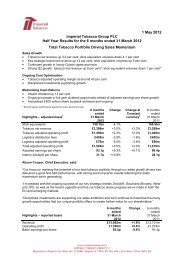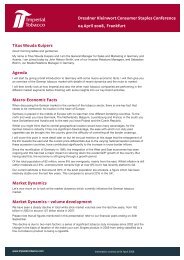Annual report 2004 (English) - PDF 3546K - Imperial Tobacco
Annual report 2004 (English) - PDF 3546K - Imperial Tobacco
Annual report 2004 (English) - PDF 3546K - Imperial Tobacco
You also want an ePaper? Increase the reach of your titles
YUMPU automatically turns print PDFs into web optimized ePapers that Google loves.
Benchmarks<br />
A world market trending toward<br />
growth in value<br />
The global cigar market, estimated at roughly<br />
15 billion units, is highly concentrated in geographic<br />
terms. More than 96% of all sales are recorded<br />
in Western Europe (Germany, France, Spain, the<br />
United Kingdom) and the United States, which<br />
account respectively for 47% and 46% of the market.<br />
Since the middle of the 1990s, these markets have<br />
registered slow volume growth and higher revenue<br />
growth, except in the United Kingdom which is<br />
weighed on by very steep taxes and retail prices.<br />
In the cigar market – which ranges from machinemade,<br />
homogenized-wrapper units weighing less<br />
than one gram to hand-made, 100%-natural cigars<br />
weighing in at 18 grams – the number of units sold<br />
is not a very pertinent indicator, and overall market<br />
trends are therefore analyzed more cogently in terms<br />
of value. A comparison of the top-of-the-line premium,<br />
hand-rolled cigar segment and the machine-rolled,<br />
mass-market segment shows a large gap between<br />
sales volumes and corresponding revenues.<br />
Worldwide cigar sales by segment<br />
Volume Value<br />
Premium 3% 28%<br />
Mass Market 97% 72%<br />
In Europe, small cigars – the Minis and cigarillos<br />
– are driving growth in almost all markets. It should<br />
be noted that certain countries such as Italy, Greece<br />
and Portugal, which are strong in terms of cigarette<br />
sales but less so for cigar consumption, have been<br />
growing sharply for several years.<br />
While growth in mature markets – the United States<br />
and Western Europe – is tending to slow down, other<br />
countries where cigar consumption is currently low<br />
are gradually developing into full-fl edged markets.<br />
Worldwide cigar sales<br />
<strong>2004</strong> (estimated)<br />
Western<br />
Europe<br />
47%<br />
Taxation<br />
7%<br />
Other countries<br />
46%<br />
North America<br />
United States<br />
The U.S. tax structure differs widely from that in<br />
France and Spain. First of all, the market is not<br />
regulated, and prices are therefore not offi cially<br />
established. Secondly, both the federal government and<br />
the individual states set taxes on cigars. The excise tax<br />
rate varies from state to state, while federal taxes vary<br />
according to the weight of the cigar: for large cigars<br />
(over three pounds for 1,000 units or over 1.36 grams<br />
per cigar), they represent 20.7% of the sales price<br />
to the distributor, with a maximum tax of $48.75 per<br />
thousand units. For small cigars, under 1.36 grams,<br />
taxes amount to $1.828 per thousand units.<br />
Spain<br />
Cigar taxes remained unchanged in <strong>2004</strong>. The excise<br />
tax was kept at 12.5% of the retail price.<br />
France<br />
The <strong>2004</strong> law on social security fi nancing set new<br />
rates for consumer taxes on cigars, resulting in an<br />
increase from 20% to 27.57%. The minimum tax was<br />
also modifi ed, rising from 55 to 89 per 1,000 units.<br />
45








